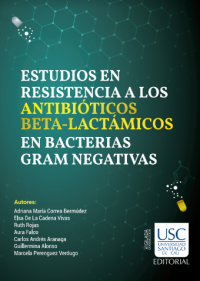Estudios en resistencia a los antibióticos beta-lactámicos en bacterias Gram negativas
PlumX
Palabras clave:
Resistencia, Beta-lactámicos, Beta-lactamasas, Acinetobacter baumannii, Klebsiella pneumoniae, Bacterias Gram negativasSinopsis
Los grupos de Investigación en Microbiología, Industria y Ambiente (GIMIA) y en Química y Biotecnología (QUIBIO) hacen parte del Centro de Estudios e Investigaciones en Ciencias Básicas Ambientales y Desarrollo Tecnológico (CICBA), adscrito a la Facultad de Ciencias Básicas de la Universidad Santiago de Cali. Desde su comienzo esta unidad académico-administrativa ha procurado estar a la vanguardia en la investigación, en la tecnología y en la innovación. Es por ello que los grupos de investigación acordes con esta macrolínea se han preocupado por compartir sus avances en investigación e innovación en un marco de responsabilidad social. Es por ello que, en este libro llamado “Estudios en resistencia a los antibióticos beta-lactámicos en bacterias Gram negativas”, se recopilan tres trabajos de investigadores que forman parte de la producción intelectual de los grupos GIMIA y QUIBIO, en alianza con el Grupo de Resistencia y Epidemiología Hospitalaria (RAEH) de la Universidad El Bosque.
Capítulos
-
Introducción
-
Capítulo 1. Resistencia bacteriana a los antibióticos betalactámicos10.35985/9789585583924.1
-
Capítulo 2. Identificación y genotipificación de aislamientos de Acinetobacter baumannii provenientes de pacientes con infecciones nosocomiales y dispositivos tipo catéter en Venezuela
-
Capítulo 3. Caracterización molecular de aislamientos resistentes a combinaciones de beta-lactámicos/inhibidores de beta-lactamasas en Colombia
-
Capítulo 4. Diseminación de clones de alto riesgo en K. pneumoniae portadora de carbapenemasa tipo KPC en Colombia
Descargas
Citas
Adler, M.; Anjum, M.; Andersson, D. I. y Sandegren, L. (2013). Influence of acquired Beta-lactamases on the evolution of spontaneous carbapenem resistance in Escherichia coli. The Journal of Antimicrobial Chemotherapy, 68(1), 51-59. https://doi.org/10.1093/jac/dks368
Ahmadi, A. y Salimizand, H. (2017). Delayed identification of Acinetobacter baumannii during an outbreak owing to disrupted blaOXA-51-like by ISAba19. International Journal of Antimicrobial Agents, 50(1), 119- 122. https://doi.org/10.1016/j.ijantimicag.2017.03.006
Ambler, R. P.; Coulson, A. F.; Frère, J. M.; Ghuysen, J. M.; Joris, B.; Forsman, M.; Levesque, R. C.; Tiraby, G. & Waley, S. G. (1991). A standard numbering scheme for the class A beta-lactamases. The Biochemical Journal, 276 (Pt 1), 269-270. https://doi.org/10.1042/bj2760269
Antunes, N. T. y Fisher, J. F. (2014). Acquired Class D Beta-Lactamases. Antibiotics (Basel, Switzerland), 3(3), 398-434. https://doi.org/10.3390/ antibiotics3030398
Baraniak, A.; Fiett, J.; Hryniewicz, W.; Nordmann, P. & Gniadkowski, M. (2002). Ceftazidime-hydrolysing CTX-M-15 extended-spectrum beta-lactamase (ESBL) in Poland. The Journal of Antimicrobial Chemotherapy, 50(3), 393-396. https://doi.org/10.1093/jac/dkf151
Bauernfeind, A.; Stemplinger, I.; Jungwirth, R.; Ernst, S. & Casellas, J. M. (1996). Sequences of beta-lactamase genes encoding CTX-M-1 (MEN-1) and CTX-M-2 and relationship of their amino acid sequences with those of other beta-lactamases. Antimicrobial Agents and Chemotherapy, 40(2), 509-513.
Bernard, H.; Tancrede, C.; Livrelli, V.; Morand, A.; Barthelemy, M. & Labia, R. (1992). A novel plasmid-mediated extended-spectrum beta-lactamase not derived from TEM- or SHV-type enzymes. The Journal of Antimicrobial Chemotherapy, 29(5), 590-592. https://doi. org/10.1093/jac/29.5.590
Brun-Buisson, C. y van Saene, H. K. (1991). SDD and the novel extended-broad-spectrum beta-lactamases. The Journal of Antimicrobial Chemotherapy, 28(1), 145-147. https://doi.org/10.1093/jac/28.1.145
Bush, K. (1989). Characterization of beta-lactamases. Antimicrobial Agents and Chemotherapy, 33(3), 259-263. https://doi.org/10.1128/ aac.33.3.259
Cantón, R.; González-Alba, J. M. y Galán, J. C. (2012). CTX-M Enzymes: Origin and Diffusion. Frontiers in Microbiology, 3, 110. https://doi. org/10.3389/fmicb.2012.00110
CDC. (2020, febrero 14). Antibiotic Resistance Threatens Everyone. Centers for Disease Control and Prevention. https://www.cdc.gov/drugresistance/index.html
Crespo, M. P.; Woodford, N.; Sinclair, A.; Kaufmann, M. E.; Turton, J.; Glover, J.; Velez, J. D.; Castañeda, C. R.; Recalde, M. & Livermore, D. M. (2004). Outbreak of carbapenem-resistant Pseudomonas aeruginosa producing VIM-8, a novel metallo-beta-lactamase, in a tertiary care center in Cali, Colombia. Journal of Clinical Microbiology, 42(11), 5094-5101. https://doi.org/10.1128/JCM.42.11.5094-5101.2004
Decousser, J. W.; Poirel, L. y Nordmann, P. (2001). Characterization of a chromosomally encoded extended-spectrum class A beta-lactamase from Kluyvera cryocrescens. Antimicrobial Agents and Chemotherapy, 45(12), 3595-3598. https://doi.org/10.1128/AAC.45.12.3595- 3598.2001
Delcour, A. H. (2009). Outer membrane permeability and antibiotic resistance. Biochimica et Biophysica Acta (BBA) - Proteins and Proteomics, 1794(5), 808-816. https://doi.org/10.1016/j.bbapap.2008.11.005
Drawz, S. M. y Bonomo, R. A. (2010). Three decades of beta-lactamase inhibitors. Clinical Microbiology Reviews, 23(1), 160-201. https://doi. org/10.1128/CMR.00037-09
Escobar Pérez, J. A.; Olarte Escobar, N. M.; Castro-Cardozo, B.; Valderrama Márquez, I. A.; Garzón Aguilar, M. I.; Martinez de la Barrera, L.; Barrero Barreto, E. R.; Marquez-Ortiz, R. A.; Moncada Guayazán, M. V. & Vanegas Gómez, N. (2013). Outbreak of NDM-1-producing Klebsiella pneumoniae in a neonatal unit in Colombia. Antimicrobial Agents and Chemotherapy, 57(4), 1957-1960. https://doi.org/10.1128/ AAC.01447-12
Falagas, M. E. y Karageorgopoulos, D. E. (2009). Extended-spectrum beta-lactamase-producing organisms. The Journal of Hospital Infection, 73(4), 345-354. https://doi.org/10.1016/j.jhin.2009.02.021
Haeggman, S.; Löfdahl, S. y Burman, L. G. (1997). An allelic variant of the chromosomal gene for class A beta-lactamase K2, specific for Klebsiella pneumoniae, is the ancestor of SHV-1. Antimicrobial Agents and Chemotherapy, 41(12), 2705-2709.
Ibuka, A.; Taguchi, A.; Ishiguro, M.; Fushinobu, S.; Ishii, Y.; Kamitori, S.; Okuyama, K.; Yamaguchi, K.; Konno, M. & Matsuzawa, H. (1999). Crystal structure of the E166A mutant of extended-spectrum beta-lactamase Toho-1 at 1.8 A resolution. Journal of Molecular Biology, 285(5), 2079-2087. https://doi.org/10.1006/jmbi.1998.2432
Jacoby, G. A. (2009). AmpC beta-lactamases. Clinical Microbiology Reviews, 22(1), 161-182, Table of Contents. https://doi.org/10.1128/ CMR.00036-08
Kusakizako, T.; Miyauchi, H.; Ishitani, R. & Nureki, O. (2019). Structural biology of the multidrug and toxic compound extrusion superfamily transporters. Biochimica Et Biophysica Acta. Biomembranes, 183154. https://doi.org/10.1016/j.bbamem.2019.183154
Livermore, D. M.; Moosdeen, F.; Lindridge, M. A.; Kho, P. & Williams, J. D. (1986). Behaviour of TEM-1 beta-lactamase as a resistance mechanism to ampicillin, mezlocillin and azlocillin in Escherichia coli. The Journal of Antimicrobial Chemotherapy, 17(2), 139-146. https:// doi.org/10.1093/jac/17.2.139
Magiorakos, A.-P.; Srinivasan, A.; Carey, R. B.; Carmeli, Y.; Falagas, M. E.; Giske, C. G.; Harbarth, S.; Hindler, J. F.; Kahlmeter, G.; Olsson-Liljequist, B.; Paterson, D. L.; Rice, L. B.; Stelling, J.; Struelens, M. J.; Vatopoulos, A.; Weber, J. T. & Monnet, D. L. (2012). Multidrug-resistant, extensively drug-resistant and pandrug-resistant bacteria: An international expert proposal for interim standard definitions for acquired resistance. Clinical Microbiology and Infection: The Official Publication of the European Society of Clinical Microbiology and Infectious Diseases, 18(3), 268-281. https://doi.org/10.1111/j.1469-0691.2011.03570.x
Mahrouki, S.; Belhadj, O.; Chihi, H.; Mohamed, B. M.; Celenza, G.; Amicosante, G. & Perilli, M. (2012). Chromosomal FFCTX-M-15 associated with ISEcp1 in Proteus mirabilis and Morganella morganii isolated at the Military Hospital of Tunis, Tunisia. Journal of Medical Microbiology, 61(Pt 9), 1286-1289. https://doi.org/10.1099/jmm.0.039487-0
Matagne, A.; Lamotte-Brasseur, J. y Frère, J. M. (1998). Catalytic properties of class A beta-lactamases: Efficiency and diversity. The Biochemical Journal, 330 (Pt 2), 581-598. https://doi.org/10.1042/bj3300581
Mathers, A. J.; Peirano, G. y Pitout, J. D. D. (2015). Escherichia coli ST131: The quintessential example of an international multiresistant highrisk clone. Advances in Applied Microbiology, 90, 109-154. https://doi. org/10.1016/bs.aambs.2014.09.002
Matsumoto, Y.; Ikeda, F.; Kamimura, T.; Yokota, Y. & Mine, Y. (1988). Novel plasmid-mediated beta-lactamase from Escherichia coli that inactivates oxyimino-cephalosporins. Antimicrobial Agents and Chemotherapy, 32(8), 1243-1246. https://doi.org/10.1128/AAC.32.8.1243
Nishiya, H. y Kunii, O. (1991). [Beta-lactamase inhibitors]. Nihon Rinsho. Japanese Journal of Clinical Medicine, 49(9), 2046-2051.
Otto, M. (2013). Community-associated MRSA: What makes them special? International Journal of Medical Microbiology, 303(6), 324-330. https://doi.org/10.1016/j.ijmm.2013.02.007
Pagès, J.-M.; James, C. E. y Winterhalter, M. (2008). The porin and the permeating antibiotic: A selective diffusion barrier in Gram-negative bacteria. Nature Reviews Microbiology, 6(12), 893-903. https://doi. org/10.1038/nrmicro1994
Paterson, D. L. y Bonomo, R. A. (2005). Extended-spectrum beta-lactamases: A clinical update. Clinical Microbiology Reviews, 18(4), 657-686. https://doi.org/10.1128/CMR.18.4.657-686.2005
Paterson, D. L.; Hujer, K. M.; Hujer, A. M.; Yeiser, B.; Bonomo, M. D.; Rice, L. B.; Bonomo, R. A. & International Klebsiella Study Group. (2003). Extended-spectrum beta-lactamases in Klebsiella pneumoniae bloodstream isolates from seven countries: Dominance and widespread prevalence of SHV- and CTX-M-type beta-lactamases. Antimicrobial Agents and Chemotherapy, 47(11), 3554-3560. https://doi. org/10.1128/aac.47.11.3554-3560.2003
Queenan, A. M. y Bush, K. (2007). Carbapenemases: The versatile beta-lactamases. Clinical Microbiology Reviews, 20(3), 440-458, table of contents. https://doi.org/10.1128/CMR.00001-07
Rice, L. B. (2012). Mechanisms of resistance and clinical relevance of resistance to Beta-lactams, glycopeptides, and fluoroquinolones. Mayo Clinic Proceedings, 87(2), 198-208. https://doi.org/10.1016/j. mayocp.2011.12.003
Schwaber, M. J.; Navon-Venezia, S.; Kaye, K. S., Ben-Ami, R.; Schwartz, D. & Carmeli, Y. (2006). Clinical and Economic Impact of Bacteremia with Extended- Spectrum-Beta-Lactamase-Producing Enterobacteriaceae. Antimicrobial Agents and Chemotherapy, 50(4), 1257-1262. https:// doi.org/10.1128/AAC.50.4.1257-1262.2006
Septimus, E. J. (2018). Antimicrobial Resistance: An Antimicrobial/Diagnostic Stewardship and Infection Prevention Approach. The Medical Clinics of North America, 102(5), 819-829. https://doi.org/10.1016/j. mcna.2018.04.005
Shriram, V.; Khare, T.; Bhagwat, R.; Shukla, R. & Kumar, V. (2018). Inhibiting Bacterial Drug Efflux Pumps via Phyto-Therapeutics to Combat Threatening Antimicrobial Resistance. Frontiers in Microbiology, 9. https://doi.org/10.3389/fmicb.2018.02990
Sougakoff, W.; Petit, A.; Goussard, S.; Sirot, D.; Bure, A. & Courvalin, P. (1989). Characterization of the plasmid genes blaT-4 and blaT-5 which encode the broad-spectrum beta-lactamases TEM-4 and TEM-5 in enterobacteriaceae. Gene, 78(2), 339-348. https://doi. org/10.1016/0378-1119(89)90236-9
Stoesser, N.; Sheppard, A. E.; Pankhurst, L.; De Maio, N.; Moore, C. E.; Sebra, R.; Turner, P.; Anson, L. W.; Kasarskis, A.; Batty, E. M.; Kos, V.; Wilson, D. J.; Phetsouvanh, R.; Wyllie, D.; Sokurenko, E.; Manges, A. R., Johnson, T. J., Price, L. B., Peto, T. E. A., … Modernizing Medical Microbiology Informatics Group (MMMIG). (2016). Evolutionary History of the Global Emergence of the Escherichia coli Epidemic Clone ST131. MBio, 7(2), e02162. https://doi.org/10.1128/mBio.02162-15
Villegas, M. V.; Kattan, J. N.; Correa, A.; Lolans, K.; Guzman, A. M.; Woodford, N.; Livermore, D.; Quinn, J. P. & Group, and the C. N. B. R. S. (2007). Dissemination of
_______________________________________________
Acinetobacter baumannii Clones with OXA-23 Carbapenemase in Colombian Hospitals. Antimicrobial Agents and Chemotherapy, 51(6), 2001-2004. https://doi.org/10.1128/AAC.00226-07
Woodford, N.; Turton, J. F. y Livermore, D. M. (2011). Multiresistant Gram-negative bacteria: The role of high-risk clones in the dissemination of antibiotic resistance. FEMS Microbiology Reviews, 35(5), 736-755. https://doi.org/10.1111/j.1574-6976.2011.00268.x
Abdi, A.; Hendiani, S.; Mohammadi, P.; Gharavi, S. (2014). Assesment of Biolfilm Formation and Resistance to Imipenem and Ciprofloxacin among Clinical Isolates of Acinetobacter baumannii in Tehran. Jundishapur J Microbiol.7(1):1-5.
Allen, DM & Hartman, BJ. (2009). Acinetobacter species. In: Mandell GL, Bennett JE, Dolin R, editors. Mandell, Douglas, and Bennett’s principles and practice of infectious diseases. 7th ed. New York: Churchill Livingstone Elsevier; p. 2881–5.
Angiolillo, G.; Fernandez, S.; Falco, A.; Aranaga, C. & Alonso G. (2017). Characterization of plasmids from E. coli SXT resistant isolates from urinary tract infections in Venezuela. Kasmera Journal, 45 (11):17-31.
Berdinelli, M. y Friedman, H. (2008). Acinetobacter biology and pathogenesis. Springer. Nueva York. E. U. A. Disponible en: https://books.google.co.ve.
Bergogne-Berezin, E. y Towner, K. (1996). Acinetobacter spp. as nosocomial pathogens: microbiological, clinical, and epidemiological features. Clin Microbiol Rev; 9(2): 148–165
Bouvet, P. y Grimont, P. (1987). Identification and biotyping of clinical isolates of Acinetobacter. In: Annales de l’Institut Pasteur/ Microbiologie. Masson SAS: Elsevier.
Brenner, P.; Otaíza, F; Bustamante R. (2004). Nosocomial infections outbreaks in Chile 1985–2002. Am J Infect Control. 32(3): E49.
Buffet, S.; Tattevin, P.; Bonnaure, M. & Jolivet, A. (2012). Emergence of resistance to antibacterial agents: the role of quaternary ammonium compounds a critical review. Int J Antimicrob Ag. 39(5): 381-389.
Chalbaud, A. y Alonso, G. (2017) Análisis y distribución de la resistencia a antibióticos en cepas bacterianas de origen hospitalario. VITAE Academia Biomédica Digital, 72, http://vitae.ucv.ve.
Chincha, O; Cornelio, E; Valverde, V. & Acevedo, M. (2013). Infecciones intrahospitalarias asociadas a dispositivos invasivos en unidades de cuidados intensivos de un hospital nacional de Lima, Perú. Rev Peru Med Exp Salud Publica.30(4):616-20.
CLSI. Performance Standards for Antimicrobial Susceptibility Testing. 22 Edition International Supplement M100-S26, Clinical and Laboratory Standards Institute. Wayne, PA: CLSI; 2012.
Diancourt, L.; Passet, V.; Nemec, A.; Dijkshoorn, L. & Brisse, S. (2010). The population structure of Acinetobacter baumannii: expanding multiresistant clones from an ancestral susceptible genetic pool. PLoS One. 5(4): e10034. doi: 10.1371/journal.pone.0010034.
Du, X.; Xu, X.; Yao, J.; Deng, K.; Chen, S.; Shen, Z.; Yang, L. & Feng, G. (2019). Predictors of mortality in patients infected with carbapenemresistant Acinetobacter baumannii: A systematic review and metaanalysis. Am J Infect Control. 16. pii: S0196-6553(19)30151-8. doi: 10.1016/j.ajic.2019.03.003.
Falah, F.; Shokoohizadeh, L. & Adabi, M. (2019). Molecular identification and genotyping of Acinetobacter baumannii isolated from burn patients by PCR and ERIC-PCR. Scars Burn Heal.; 5: 2059513119831369. doi: 10.1177/2059513119831369
Falco, A; Barrios, Y; Torres, L; Sandrea, L, Takiff, H. (2017). Epidemiología molecular de aislados clínicos de Klebsiella pneumoniae productores de carbapenemasas tipo KPC provenientes de dos hospitales públicos en los estados Carabobo y Zulia, Venezuela. Inv Clin; 58: 3-21.
Gales, A.; Jones, R.; Forward, K.; Linares, J.; Sader, H. & Verhoef, J. (2001). Emerging importance of multidrug-resistant Acinetobacter species and Stenotrophomonas maltophilia as pathogens in seriously ill patients: geographic patterns, epidemiological features, and trends in the SENTRY. Antimicrobial Surveillance Program (1997–1999). Clin Infect Dis. 32(2supl). pp. 104–113.
González, M.; Izquierdo, A.; Luque, M.; Sánchez, A.; Díaz, M. & Torres, M. (2002). Infecciones urológicas por Acinetobacter. Estudio de casos y aplicación del protocolo de actuación de enfermería. Asoc. Esp. Enf. Uro. 28 (82): 28- 32.
Hernández, A.; García, E.; Yagüe, G. & Gómez, J. (2010). Acinetobacter baumanii multirresistente: situación clínica actual y nuevas perspectivas. Rev Esp Quimioter.23(1):12-19.
Horcajada, J.; Vila, J.; Moreno, A.; Ruiz, J.; Martínez, J.; Sanchez, M.;, Soriano, E. & Mensa, J. (2002). Molecular epidemiology and evolution of resistance to quinilones in Escherichia coli after prolongued administration of ciprofloxacin in patients with prostatitis. J. Antimicrob Chemother. 49(1): 55-59.
Kang, H. y Dunne, W. (2003). Stability of Repetitive-Sequence PCR Patterns with Respect to Culture Age and Subculture Frequency. Journal of Clinical Microbiology; 41 (6): 2694– 2696.
Karaiskos, I.; Lagou, S.; Pontikis, K.; Rapti, V. & Poulakou, G. (2019). The “Old” and the “New” Antibiotics for MDR Gram-Negative Pathogens: For Whom, When, and How. Front Public Health.; 7:151. doi: 10.3389/ fpubh.2019.00151.
Lemos, E.; Restrepo, F.; Alvis, N.; Quevedo, E.; Cañon, O. & León, Y. (2011). Mortalidad por Acinetobacter baumannii en unidades de cuidados intensivos en Colombia. Rev Panam Salud Publica.30(4): 287–294.
Lin, L.; Ling, B. & Li, X. (2009). Distribution of multidrog efflux pump genes adeABC, adeDE, and adeIJK, and class 1 integron genes in multipleantimicrobial-resistant clinical isolates of Acinetobacter baumannii. Acinetobacter calcoaceticus complex. Int. J. Microb. Agents. 33(1): 27- 32
Levesque, C.; Piche, L.; Larose, C. & Roy, P. (1995). PCR mapping of integrons revealsseveral novel combinations of resistance genes. Antimicrob Agents Chemother. 39(1):185-191.
MacFaddin, J. (2003). Pruebas bioquímicas para la identificación de bacterias de importancia clínica. 3ra. Edición. Ciudad de México, México. Editorial Médica Panamericana, 2003.
MPPCTII. (2009). Ministerio del Poder Popular para la Ciencia, Tecnología e Industrias Intermedias. Fondo Nacional de Ciencia, Tecnología e Innovación. Código de Bioética y Bioseguridad. Tercera Edición. República Bolivariana de Venezuela. Caracas.
Ojeda, E. y Megías, G. (2000). Infecciones asociadas a catéteres. Disponible en: http://www.uninet.edu/cin2000/conferences/ojeda/ojeda.html. Consultado en agosto de 2019.
Pancholi, P.; Healy, M.; Bittner, T.; Webb, R.; Fan, W.; Aiello, A.; Larson, E. & Phyllis, D. (2005). Molecular Characterization of Hand Flora and Environmental Isolates in a Community Settings. J. Clin. Microbiol.43(10): 5202- 5207
Padgett, D.; Luque, M.; Rivera, D.; Zepeda, L. & Hernández, A. (2013). Vigilancia de infecciones nosocomiales: experiencia en hospital de especialidades del Instituto Hondureño de Seguridad Social, 2006- 2012. Rev Med Hondur. 81(2-4):68- 72.
Peleg, AY.; Seifert, H. & Paterson, DL. (2008). Acinetobacter baumannii: emergence of a successful pathogen. Clin Microbiol Rev; 21(3): 538– 582
Peleg, A. y Hooper, D. 2010. Hospital-Acquired Infections Due to GramNegative Bacteria. N Engl J Med. 362(19): 1804-1813.
Pitteloud, J.; Villarroel, E.; Figueredo, A. & Silva, M. (2007). Boletín de infecciones Hospitalarias. Subcomisión de Infecciones H.U.C. Vol. 19.
Seng, P.; Rolain, JM; Fournier, PE: La, SB; Drancourt, M. & Raoult, D. (2010). MALDITOF–mass spectrometry applications in clinical microbiology. Future Microbiol; 5:1733–54.
Ramírez, M.; Aranza, J.; Varela, M.; García, A.; Vélez, G.; Salcedo, R.; Fajardo, M.; Cruz, M. & Moreno, F. (2013). Brote de infección nosocomial de infecciones respiratorias bajas por Acinetobacter baumannii en un servicio de medicina interna de un hospital general de la Ciudad de México. Med. Int. Mex. 29(3: 250- 256
Richards, M.; Edwards, J.; Culver, D. & Gaynes, R. (2000). Nosocomial infections in medical intensive care units in the United States. Infect Control Hosp Epidemiol.21(8):510-5.
Rivas, J.; Guzmán, M.; Redondo, C.; Moncada, L.; Rahn, K.; Machiste, M.; Fernandez, S. & Alonso, G. (2008). Genotipificación de cepas bacterianas aisladas de diferentes centros de salud de Venezuela. Mem Inst Biol Exp. 5:105-108.
Rothman, K. (2000) Declaration of Helsinki should be strengthened. BMJ. 12; 321(7258):442-445.
Seisdedos, R.; Conde, M.; Castellanos, J.; García, A.; Valenzuela, J. & Fraga, M. (2012). Infecciones relacionadas con el catéter venoso central en pacientes con nutrición parenteral total. Nutr. Hosp. 27(3):775-780.
Sevillano, E. y Gallego, L. Molecular techniques for detection and control of nosocomial infections caused by Acinetobacter baumannii. In: Mendez- Vilas A, editor. Science against microbial pathogens: communicating current research and technological advances. Badajoz, Spain: Formatex Research Center; 2011. p. 495–503. http://www. formatex. info/microbiology3/book/495-503.pdf.
Tenover, F.; Arbeit, R.; Goering, R.; Mickelsen, P.; Murray, B.; Persing, D. & Swaminathan, B. (1995). Interpreting chromosomal DNA restriction patterns produced by pulsed-field gel electrophoresis: criteria for bacterial strain typing. J. Clin. Microbiol. 33(9): 2233- 2239.
Toba, F.; Falco, A.; Aranaga, CA & Alonso, G. (2018). Caracterización de bacterias aisladas en un reservorio de agua de Venezuela. Una aproximación a la multiresistencia bacteriana en ambientes naturales. En: La contaminación industrial de aguas. Una mirada microbiológica y molecular. pp- 93-117. Santiago de Cali, Colombia. Editorial USC.
Turton, J.; Woodford, N.; Glover, J.; Yarde, S.; Kaufman, M. & Pitt, T. (2010). Identification of Acinetobacter baumannii by detection of the blaOXA-51-like carbapenemase gene intrinsic to this species. J. Clin. Microbiol.44(8):2974- 2976
Vílchez, G. y Alonso, G. (2009). Alcances y limitaciones de los métodos de epidemiología molecular basados en el análisis de ácidos nucleicos. Revista de la Sociedad Venezolana de Microbiología; 29: 6-12.
Woodford, N.; Ellington, M.; Coelho, J.; Turton, J.; Ward, M.; Brown, S.; Amyes, S. & Livermore D. (2006). Multiplex PCR for genes encoding prevalent OXA carbapenemases in Acinetobacter spp. Int. J. Anitimicrob. Agents. 27(4): 351- 353.
___________________________________________________________________________________
Bonomo, R. A.; S. A. Rudin y D. M. Shlaes (1997). “Tazobactam Is a Potent Inactivator of Selected Inhibitor-Resistant Class A Beta-Lactamases.” FEMS Microbiology Letters 148 (1):59–62. https://doi.org/10.1016/ S0378-1097(97)00013-X.
Bradford ,PA. (2001). “Extended-Spectrum B-Lactamases in the 21st Century: Characterization, Epidemiology, and Detection of This Important Resistance Threa.” Clinical Microbiology Reviews 14 (4):933–51. https://doi.org/10.1128 /CMR .14.4.933.
Bush, Karen y Patricia A. Bradford (2016). B -Lactams and B -Lactamase Inhibitors: An Overview, No. Table 1.
Cantón, R.; M. I. Morosini; O. Martin; S. De La Maza & E. Gomez G. De La Pedrosa. (2008). “IRT and CMT Beta-Lactamases and Inhibitor Resistance.” Clinical Microbiology and Infection 14 (SUPPL. 1):53–62. https://doi.org/10.1111/j.1469-0691.2007.01849.x.
Cantón, R.; González-Alba, J. y Galán, J. (2012). “CTX-M Enzymes: Origin and Diffusion.” Frontiers in Microbiology 3 (APR). https://doi.org/10.3389/ fmicb.2012.00110.
Cantón, R.; Pérez-Vázquez, M.; Oliver, A.; Coque, TM.; Loza, E.; Ponz, F. & Baquero, F. (2001). “Validation of the VITEK2 and the Advance Expert System with a Collection of Enterobacteriaceae Harboring Extended Spectrum or Inhibitor Resistant Beta-Lactamases.” Diagnostic Microbiology and Infectious Disease 41 (1–2):65–70. https://doi. org/10.1016/S0732-8893(01)00286-3
Casellas, JM.; Tomé, G.; Bantar, C.; Bertolini, P.; Blázquez, N.; Borda, N.; Couto, E.; et al. (2003). “Argentinean Collaborative Multicenter Study on the in Vitro Comparative Activity of Piperacillin-Tazobactam against Selected Bacterial Isolates Recovered from Hospitalized Patients.” Diagnostic Microbiology and Infectious Disease 47 (3):527–37. https:// doi.org/10.1016/S0732-8893(03)00131-7.
Chaïbi, E. B.; D. Sirot; G. Paul & R. Labia (1999). “Inhibitor-Resistant TEM Beta-Lactamases: Phenotypic, Genetic and Biochemical Characteristics.” Journal of Antimicrobial Chemotherapy 43 (4):447–58. https://doi. org/10.1093/jac/43.4.447.
Coque, T M; F Baquero y R Canton (2008). “Increasing Prevalence of ESBL - Producing Enterobacteriaceae in Europe.” Eurosurveillance 13 (47):1–11.
Correa, A., del Campo, R., Perenguez, M., Blanco, V. Rodríguez-Baños, M., Perez, F., Maya, J. et al. (2015). “Dissemination of High-Risk Clones of Extensively Drug-Resistant Pseudomonas Aeruginosa in Colombia.” Antimicrobial Agents and Chemotherapy 59 (4):2421–25. https://doi. org/10.1128/AAC.03926-14.
Dautzenberg, M. J.D., M. R. Haverkate, M. J.M. Bonten, & M. C.J. Bootsma. 2016. “Epidemic Potential of Escherichia Coli ST131 and Klebsiella Pneumoniae ST258: A Systematic Review and Meta-Analysis.” BMJ Open 6 (3). https://doi.org/10.1136/bmjopen-2015-009971.
Dowzicky, MJ & Park, CH. (2008).Update on antimicrobial susceptibility rates among gram-negative and gram-positive organisms in the United States: results from the Tigecycline Evaluation and Surveillance Trial (TEST) 2005 to 2007. Clin Ther. 2008;30(11):2040-2050.
Dubois, V.; Poirel, L.; Demarthe, F.; Arpin, C.; Coulange, L.; Minarini, LA.; Bezian, MC.; Nordmann, P. & Quentin, C. (2008). “Molecular and Biochemical Characterization of SHV-56, a Novel Inhibitor-Resistant Beta-Lactamase from Klebsiella Pneumoniae.” Antimicrobial Agents and Chemotherapy 52 (10):3792–94. https://doi.org/10.1128/ AAC.00387-08.
Esparza, G.; Villegas, MV.; Vega, S.; en nombre de los Comités de Microbiología & PROA y Resistencia de la Asociación Panamericana de Infectología (API) y de Antimicrobianos (2019). “Recomendaciones sobre el tamizaje y uso de Piperacilina/tazobactam En Infecciones por Productores de Betalactamasas de Espectro Extendido (BLEEs).” Rev Panam Enf Inf 0 (0):1–3.
Gutmann, L.; B. Ferre; F. W. Goldstein; N. Rizk; E. Pinto-Schuster; J. F. Acar & E. Collatz (1989). “SHV-5, a Novel SHV-Type Beta-Lactamase That Hydrolyzes Broad-Spectrum Cephalosporins and Monobactams.” Antimicrobial Agents and Chemotherapy 33 (6):951–56. https://doi. org/10.1128/AAC.33.6.951.
Kaye, KS, Gold, HS, Schwaber, MJ, et al. (2004). “Variety of Beta-Lactamases Produced By.pdf.” Antimicrobial Agents and Chemotherapy 48:1520– 25.
Knothe, H.; Shah, P.; Krcmery, V.; Antal, M. & Mitsuhashi, S. (1983). “Transferable Resistance to Cefotaxime, Cefoxitin, Cefamandole and Cefuroxime in Clinical Isolates of Klebsiella pneumoniae and Serratia Marcescens.” Infection 11 (6):315–17. https://doi.org/10.1007/ BF01641355.
Quinteros, M.; Radice, M.; Gardella, N.; Rodriguez, M. M.; Costa, N.; Korbenfeld, D.; Couto, E.; Gutkind, G. & Microbiology Study Group (2003). Extended-spectrum beta-lactamases in enterobacteriaceae in Buenos Aires, Argentina, public hospitals. Antimicrobial agents and chemotherapy, 47(9), 2864–2867. https://doi.org/10.1128/ aac.47.9.2864-2867.2003
Martín, O.; Valverde, A.; Morosini, MI.; Rodríguez-Domínguez, M.; RodríguezBaños, M.; Coque, TM.; Cantón, R.; del Campo, R. (2010). “Population Analysis and Epidemiological Features of Inhibitor-ResistantTEM-Beta-Lactamase-Producing Escherichia Coli Isolates from Both Community and Hospital Settings in Madrid, Spain.” Journal of Clinical Microbiology 48 (7):2368–72. https://doi.org/10.1128/ JCM.00608-10.
Mathers, AJ; Peirano, G; Pitout, JD. (2015). The role of epidemic resistance plasmids and international high-risk clones in the spread of multidrug-resistant Enterobacteriaceae. Clin Microbiol Rev. 2015;28(3):565-591. doi:10.1128/CMR.00116-14
Mukherjee, SK.; Mandal, RS.; Das, S.; Mukherjee, M. (2018). Effect of non-Betalactams on stable variants of inhibitor-resistant TEM Beta-lactamase in uropathogenic Escherichia coli: implication for alternative therapy. J Appl Microbiol. 2018;124(3):667-681. doi:10.1111/jam.13671
Peirano, G. y Johann, D. D. Pitout. (2010). “Molecular Epidemiology of Escherichia Coli Producing CTX-M B-Lactamases: The Worldwide Emergence of Clone ST131 O25: H4.” International Journal of Antimicrobial Agents. https://doi.org/10.1016/j.ijantimicag.2009.11.003.
Ríos, E; López, MC; Rodríguez-Avial, I; Pena, I; Picazo, JJ. (2015). Characterization of Inhibitor-Resistant TEM Beta-Lactamases and Mechanisms of Fluoroquinolone Resistance in Escherichia coli Isolates. Microb Drug Resist. 2015;21(5):512-515. doi:10.1089/ mdr.2015.0039
Robin, F.; J. Delmas; C. Chanal; D. Sirot; J. Sirot & R. Bonnet (2005). “TEM109 (CMT-5), a Natural Complex Mutant of TEM-1 Beta-Lactamase Combining the Amino Acid Substitutions of TEM-6 and TEM-33 (IRT-5).” Antimicrobial Agents and Chemotherapy 49 (11):4443–47. https://doi.org/10.1128/AAC.49.11.4443-4447.2005.
Sader, HS.; Rhomberg, PR.; Fuhrmeister, AS.; Mendes, RE.; Flamm, RK.; Jones, RN. (2019). Antimicrobial Resistance Surveillance and New Drug Development. Open Forum Infect Dis. 2019;6(Suppl 1):S5-S13. Published 2019 Mar 15. doi:10.1093/ofid/ofy345
Schuetz, AN; Reyes, S.; Tamma, PD. (2018). “Crossm Positive Organisms”. Journal of Clinical and Diagnostic Research 56 (3):1–8.
Stapleton, P.; Wu, P. J.; King, A.; Shannon, K.; French, G. & Phillips, I. (1998). Incidence and Mechanisms of Resistance to the Combination of Amoxicillin and Clavulanic Acid in Escherichia coli. Antimicrobial Agents and Chemotherapy, 42(10), 2773..
Villegas, MV.; Correa, A.; Perez, F.; Miranda, MC.; Zuluaga, T. & Quinn, JP. (2004). “Prevalence and Characterization of Extended-Spectrum Beta-Lactamases in Klebsiella Pneumoniae and Escherichia Coli Isolates from Colombian Hospitals”. Diagnostic Microbiology and Infectious Disease 49 (3):217–22. https://doi.org/10.1016/j.diagmicrobio.2004.03.001
Waltner-Toews RI.; Paterson, DL.; Qureshi, ZA.; et al. (2011). Clinical characteristics of bloodstream infections due to ampicillinsulbactam-resistant, non-extended- spectrum-beta-lactamaseproducing Escherichia coli and the role of TEM-1 hyperproduction. Antimicrob Agents Chemother. 2011;55(2):495-501. doi:10.1128/ AAC.00797-10
____________________________________________________
Alós, J.-I. (2015). [Antibiotic resistance: A global crisis]. Enfermedades Infecciosas Y Microbiologia Clinica, 33(10), 692-699. https://doi.org/10.1016/j.eimc.2014.10.004
Bae, I. K.; Kim, J.; Sun, J. Y. H.; Jeong, S. H.; Kim, Y.-R.; Wang, K.-K. & Lee, K. (2014). Comparison of pulsed-field gel electrophoresis & repetitive sequence-based PCR methods for molecular epidemiological studies of Escherichia coli clinical isolates. The Indian Journal of Medical Research, 140(5), 679-685.
Barton, B. M.; Harding, G. P. y Zuccarelli, A. J. (1995). A general method for detecting and sizing large plasmids. Analytical Biochemistry, 226(2), 235-240. https://doi.org/10.1006/abio.1995.1220
Bratu, S.; Landman, D.; Alam, M.; Tolentino, E. y Quale, J. (2005). Detection of KPC carbapenem-hydrolyzing enzymes in Enterobacter spp. From Brooklyn, New York. Antimicrobial Agents and Chemotherapy, 49(2), 776-778. https://doi.org/10.1128/AAC.49.2.776-778.2005
Brisse, S.; Fevre, C.; Passet, V.; Issenhuth-Jeanjean, S.; Tournebize, R.; Diancourt, L. & Grimont, P. (2009). Virulent clones of Klebsiella pneumoniae: Identification and evolutionary scenario based on genomic and phenotypic characterization. PloS One, 4(3), e4982. https://doi. org/10.1371/journal.pone.0004982
Carattoli, A.; Bertini, A.; Villa, L.; Falbo, V.; Hopkins, K. L. & Threlfall, E. J. (2005). Identification of plasmids by PCR-based replicon typing. Journal of Microbiological Methods, 63(3), 219-228. https://doi. org/10.1016/j.mimet.2005.03.018
Correa, A.; Montealegre, M. C.; Mojica, M. F.; Maya, J. J.; Rojas, L. J.; De La Cadena, E.P.; Ruiz, S. J.; Recalde, M.; Rosso, F.; Quinn, J. P. & Villegas, M. V. (2012). First report of a Pseudomonas aeruginosa isolate coharboring KPC and VIM carbapenemases. Antimicrobial Agents and Chemotherapy, 56(10), 5422-5423. https://doi.org/10.1128/AAC.00695-12
Cuzon, G.; Naas, T.; Truong, H.; Villegas, M. V., Wisell, K. T.; Carmeli, Y.; Gales, A. C.; Venezia, S. N.; Quinn, J. P. & Nordmann, P. (2010). Worldwide diversity of Klebsiella pneumoniae that produce beta-lactamase blaKPC-2 gene. Emerging Infectious Diseases, 16(9), 1349-1356. https:// doi.org/10.3201/eid1609.091389
Fey, P. D. y Rupp, M. E. (2003). Molecular epidemiology in the public health and hospital environments. Clinics in Laboratory Medicine, 23(4), 885-901. https://doi.org/10.1016/s0272-2712(03)00100-8
Gautom, R. K. (1997). Rapid pulsed-field gel electrophoresis protocol for typing of Escherichia coli O157:H7 and other gram-negative organisms in 1 day. Journal of Clinical Microbiology, 35(11), 2977-2980.
Karampatakis, T.; Antachopoulos, C.; Iosifidis, E.; Tsakris, A. & Roilides, E. (2016). Molecular epidemiology of carbapenem-resistant Klebsiella pneumoniae in Greece. Future Microbiology, 11, 809-823. https://doi. org/10.2217/fmb-2016-0042
Ko, K. S.; Lee, J.-Y.; Baek, J. Y.; Suh, J.-Y.; Lee, M. Y.; Choi, J. Y.; Yeom, J.-S.; Kim, Y.-S.; Jung, S.-I.; Shin, S. Y.; Heo, S. T.; Kwon, K. T.; Son, J. S.; Kim, S.-W.; Chang, H.-H.; Ki, H.
K.; Chung, D. R.; Peck, K. R. & Song, J.-H. (2010). Predominance of an ST11 extended-spectrum beta-lactamase-producing Klebsiella pneumoniae clone causing bacteraemia and urinary tract infections in Korea. Journal of Medical Microbiology, 59(Pt 7), 822-828. https://doi.org/10.1099/jmm.0.018119-0
Lopez, J. A.; Correa, A.; Navon-Venezia, S.; Correa, A. L.; Torres, J. A.; Briceño, D. F.; Montealegre, M. C.; Quinn, J. P.; Carmeli, Y. & Villegas, M. V. (2011). Intercontinental spread from Israel to Colombia of a KPC-3-producing Klebsiella pneumoniae strain. Clinical Microbiology and Infection: The Official Publication of the European Society of Clinical Microbiology and Infectious Diseases, 17(1), 52-56. https://doi.org/10.1111/ j.1469-0691.2010.03209.x
Mathers, A. J.; Peirano, G. y Pitout, J. D. D. (2015). Escherichia coli ST131: The quintessential example of an international multiresistant high-risk clone. Advances in Applied Microbiology, 90, 109-154. https://doi. org/10.1016/bs.aambs.2014.09.002
Mojica, M. F.; Correa, A.; Vargas, D. A.; Maya, J. J.; Montealegre, M. C.; Rojas, L. J.; Ruiz, S. J.; Quinn, J. P.; Villegas, M. V. & Colombian Nosocomial Bacterial Resistance
Study Group. (2012). Molecular correlates of the spread of KPC-producing Enterobacteriaceae in Colombia. International Journal of Antimicrobial Agents, 40(3), 277-279. https://doi. org/10.1016/j.ijantimicag.2012.05.006
Morehead, M. S. y Scarbrough, C. (2018). Emergence of Global Antibiotic Resistance. Primary Care, 45(3), 467-484. https://doi.org/10.1016/j. pop.2018.05.006 Naas, T.; Cuzon, G.; Villegas, M.-V.; Lartigue, M.-F.; Quinn, J. P. & Nordmann, P. (2008). Genetic structures at the origin of acquisition of the beta-lactamase bla KPC gene. Antimicrobial Agents and Chemotherapy, 52(4), 1257-1263. https://doi.org/10.1128/AAC.01451-07
Naas, T.; Oueslati, S.; Bonnin, R. A.; Dabos, M. L.; Zavala, A.; Dortet, L.; Retailleau, P. & Iorga, B. I. (2017). Beta-lactamase database (BLDB) –structure and function. Journal of Enzyme Inhibition and Medicinal Chemistry, 32(1), 917-919. https://doi.org/10.1080/14756366.2017. 1344235
Navon-Venezia, S.; Chmelnitsky, I.; Leavitt, A.; Schwaber, M. J.; Schwartz, D. & Carmeli, Y. (2006). Plasmid-mediated imipenem-hydrolyzing enzyme KPC-2 among multiple carbapenem-resistant Escherichia coli clones in Israel. Antimicrobial Agents and Chemotherapy, 50(9), 3098- 3101. https://doi.org/10.1128/AAC.00438-06
Ovalle, M. V.; Saavedra, S. Y.; González, M. N.; Hidalgo, A. M.; Duarte, C. & Beltrán, M. (2017). Results of the national surveillance of antimicrobial resistance of Enterobacteriaceae and Gram negative bacilli in health care-associated infections in Colombia, 2012-2014. Biomédica, 37(4), 473. https://doi.org/10.7705/biomedica.v37i4.3432
Podschun, R. y Ullmann, U. (1998). Klebsiella spp. as nosocomial pathogens: Epidemiology, taxonomy, typing methods, and pathogenicity factors. Clinical Microbiology Reviews, 11(4), 589-603.
Poirel, L. y Nordmann, P. (2002). Acquired carbapenem-hydrolyzing beta-lactamases and their genetic support. Current Pharmaceutical Biotechnology, 3(2), 117-127. https://doi.org/10.2174/1389201023378427
Robledo, I. E.; Aquino, E. E.; Santé, M. I.; Santana, J. L.; Otero, D. M.; León, C. F. y Vázquez, G. J. (2010). Detection of KPC in Acinetobacter spp. In Puerto Rico. Antimicrobial Agents and Chemotherapy, 54(3), 1354- 1357. https://doi.org/10.1128/AAC.00899-09
Rojas, L. J.; Weinstock, G. M.; De La Cadena, E.; Diaz, L.; Rios, R.;Hanson, B. M.; Brown, J. S.; Vats, P.; Phillips, D. S.; Nguyen, H.; Hujer, K. M.;Correa, A.; Adams, M. D.; Perez, F.; Sodergren, E.; Narechania, A.;Planet, P. J.Villegas, M. V.; Bonomo, R. A. & Arias, C. A. (2018). An Analysis of the Epidemic of Klebsiella pneumoniae Carbapenemase-Producing K. pneumoniae: Convergence of Two Evolutionary Mechanisms Creates the “Perfect Storm”. The Journal of Infectious Diseases, 217(1), 82-92. https://doi.org/10.1093/infdis/jix524
Samuelsen, Ø.; Naseer, U.; Tofteland, S.; Skutlaberg, D. H.; Onken, A.; Hjetland, R.; Sundsfjord, A. & Giske, C. G. (2009). Emergence of clonally related Klebsiella pneumoniae isolates of sequence type 258 producing plasmid-mediated KPC carbapenemase in Norway and Sweden. The Journal of Antimicrobial Chemotherapy, 63(4), 654-658. https://doi.org/10.1093/jac/dkp018
Shen, P.; Wei, Z.; Jiang, Y.; Du, X.; Ji, S.; Yu, Y.,& Li, L. (2009). Novel genetic environment of the carbapenem-hydrolyzing beta-lactamase KPC2 among Enterobacteriaceae in China. Antimicrobial Agents and Chemotherapy, 53(10), 4333-4338. https://doi.org/10.1128/AAC.00260- 09
Solomon, S. L. y Oliver, K. B. (2014). Antibiotic resistance threats in the United States: Stepping back from the brink. American Family Physician, 89(12), 938-941.
Szijártó, V.; Guachalla, L. M.; Hartl, K.; Varga, C.; Banerjee, P.; Stojkovic, K.; Kaszowska, M.; Nagy, E.; Lukasiewicz, J. & Nagy, G. (2016). Both clades of the epidemic KPC-producing Klebsiella pneumoniae clone ST258 share a modified galactan O-antigen type. International Journal of Medical Microbiology, 306(2), 89-98. https://doi.org/10.1016/j. ijmm.2015.12.002
Tsakris, A.; Tsioni, C.; Pournaras, S.; Polyzos, S.; Maniatis, A. N. & Sofianou, D. (2003). Spread of low-level carbapenem-resistant Acineto- 121 Adriana Correa y Marcela Perenguez bacter baumannii clones in a tertiary care Greek hospital. The Journal of Antimicrobial Chemotherapy, 52(6), 1046-1047. https://doi. org/10.1093/jac/dkg470
Van Duin, D. y Doi, Y. (2017). The global epidemiology of carbapenemase-producing Enterobacteriaceae. Virulence, 8(4), 460-469. https:// doi.org/10.1080/21505594.2016.1222343
Villegas, M. V.; Lolans, K.; Correa, A.; Suarez, C. J.; Lopez, J. A.;Vallejo, M.; Quinn, J. P. &
Colombian Nosocomial Resistance Study Group. (2006). First detection of the plasmid-mediated class A carbapenemase KPC-2 in clinical isolates of Klebsiella pneumoniae from South America. Antimicrobial Agents and Chemotherapy, 50(8), 2880-2882. https://doi.org/10.1128/AAC.00186-06
Woodford, N.; Turton, J. F. y Livermore, D. M. (2011). Multiresistant Gramnegative bacteria: The role of high-risk clones in the dissemination of antibiotic resistance. FEMS Microbiology Reviews, 35(5), 736-755. https://doi.org/10.1111/j.1574-6976.2011.00268.x
Yigit, H.; Queenan, A. M.; Anderson, G. J.; Domenech-Sanchez, A.; Biddle, J. W.; Steward, C. D.; Alberti, S.; Bush, K. & Tenover, F. C. (2001). Novel carbapenem-hydrolyzing beta-lactamase, KPC-1, from a carbapenem-resistant strain of Klebsiella pneumoniae. Antimicrobial Agents and Chemotherapy, 45(4), 1151-1161. https://doi.org/10.1128/ AAC.45.4.1151-1161.2001


























